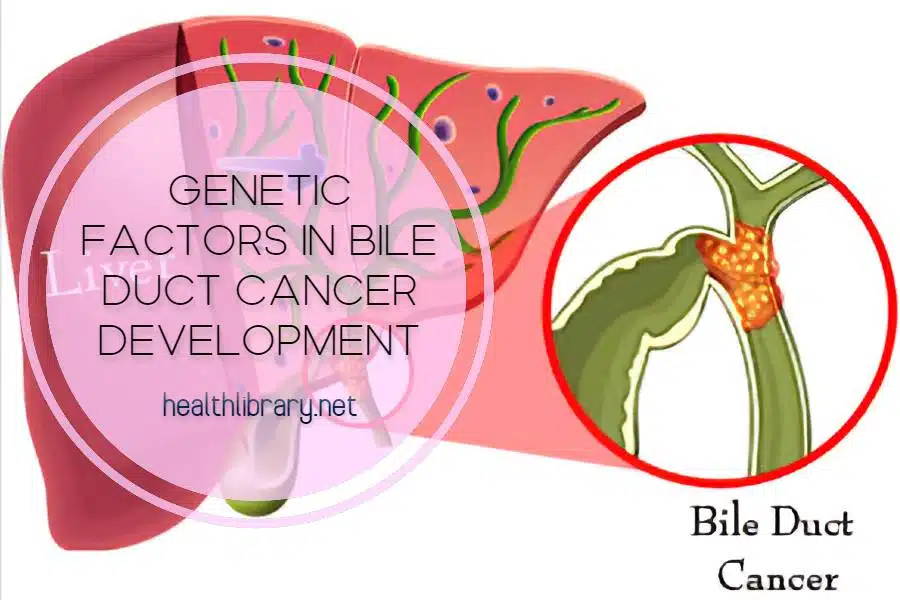Bile duct cancer is a very rare form of cancer that affects the tubes that carry bile from the liver to the small intestine. While genetic factors may predispose some individuals to developing bile duct cancer, identifying these specific gene variations can sometimes be difficult.

Overview of Bile Duct Cancer Development
Understanding the hereditary variables that raise a person’s risk of bile duct cancer is critical for prevention and therapy.
Certain gene mutations, such as those in the DNA mismatch repair (MMR) genes, can enhance a person’s chance of developing bile duct cancer. Furthermore, certain people with particular disorders may be predisposed to this kind of cancer.
Fortunately, knowing the molecular processes involved in the development of bile duct cancer is revealing more genetic targets that may help detect risks and open up new treatment prospects.
Read: 5 Common Risk Factors Linked to Benign Prostate Hypertrophy
Role of Genetics and Hereditary Factors in Bile Duct Cancer Development
Identifying a person’s genetic risk of bile duct cancer is critical for early detection, risk assessment, and better treatment.
According to current studies, inherited gene mutations such as those found in the MMR genes can enhance a person’s chance of getting bile duct cancer.
Furthermore, those with certain genetic disorders, such as familial adenomatous polyposis (FAP), are more likely to acquire this kind of cancer.
Understanding these hereditary pathways can assist clinicians in identifying and managing their patients’ bile duct cancer risks.
Common Genetic Mutations Associated with Bile Duct Cancer Risks
A person’s chance of acquiring bile duct cancer can be increased by genetic abnormalities. These genetic mutations include MMR gene mutations as well as some hereditary disorders such as familial adenomatous polyposis (FAP).
Furthermore, those with particular mutations are more likely to acquire this kind of cancer. A mutation in the KRAS gene, for example, is linked to an increased risk of developing intrahepatic cholangiocarcinoma (IHCC), whereas a mutation in the APC gene is linked to an increased risk of developing extrahepatic cholangiocarcinoma (EHCC).
Awareness and understanding of these frequent genetic abnormalities can assist medical practitioners in early detection and improved care methods for individuals at increased risk of bile duct cancer.
Preventative Measures to Reduce the Risk of Developing Bile Duct Cancer
Because genetic abnormalities are linked to an increased risk of developing bile duct cancer, those who have these mutations should take precautions.
Regular screenings, such as ultrasounds, MRIs, and CT scans, are used to detect precancerous growths in the liver during routine check-ups.
Eating a well-balanced diet and avoiding dangerous habits like smoking and excessive alcohol intake might also help minimize the risk.
Finally, taking plenty of exercise can help boost the immune system and keep it running smoothly, lowering the risk of developing bile duct cancer.
Available Treatments for Those Diagnosed With Bile Duct Cancer or at High Risk of Developing It
There are numerous therapy options available if a person has bile duct cancer or is at high risk of acquiring it.
In situations when the tumour is localized and treatable, surgery is the primary therapy. Other treatments, such as radiation therapy and chemotherapy, may be required if the tumor cannot be removed surgically or if cancer has spread.
Targeted treatments employ medications that directly target cancer cells while leaving healthy cells alone.
Immunotherapies have also been utilized to strengthen the patient’s immune system in order to combat cancer.
How common is bile duct cancer?
Bile duct cancer is a rare form of cancer, with an estimated incidence rate of approximately 2 to 5 cases per 100,000 individuals in the United States.
This type of cancer is relatively uncommon, yet it can have a devastating impact on those affected by it.
The incidence rate of bile duct cancer is higher in certain populations, such as those with a history of chronic liver disease or cirrhosis.
Treatment options for this type of cancer are limited, making early detection and diagnosis essential for improving outcomes.
How is bile duct cancer diagnosed?
A medical history review, physical examination, imaging tests (such as ultrasound, CT scan, and MRI), and biopsy are used to detect bile duct cancer.
Endoscopic retrograde cholangiopancreatography (ERCP) or percutaneous transhepatic cholangiography (PTC) biopsy is frequently required for a definite diagnosis.
What does bile duct cancer look like?
A tumor or lump in the liver, yellowing of the skin and eyes (jaundice), stomach discomfort, and itching are all symptoms of bile duct cancer.
However, these symptoms can also be symptomatic of other illnesses, and the final diagnosis should be made by a medical specialist.